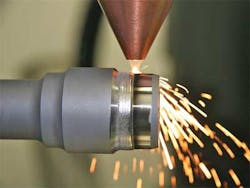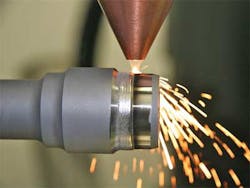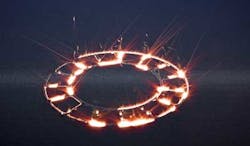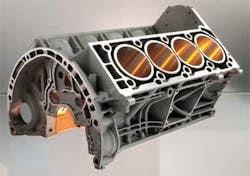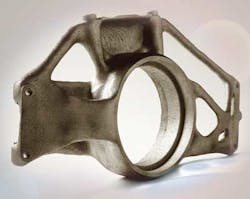Laser additive manufacturing
All Rights Reserved, Joining Technologies.
Elizabeth Kautzmann
When weighing the arguments for and against championing laser additive manufacturing (LAM) as a legitimate contender in the fight to influence global manufacturing and deliver powerful and inspired solutions to a dynamic universe, it may be beneficial to capture a snapshot of the discussions encircling conventional manufacturing and AM technology. Once the perspectives are laid out, and granted just a pittance of regard, LAM will emerge as a fearsome foe, fantastical indulgence, and a formidable ally; it will be for the reader and history to decide.
Culture of innovation
Current manufacturing processes are a reflection of the solutions developed within the past cultural and societal eras in which they occur. Designs expressing the engineer's or visionary's understanding, and the resulting answer to the problem or existing need at hand, in time produce advancement. However, anticipating possible unknown requirements must be weighed significantly in proposals as well. Solutions that are capable of maturing and adapting in order to serve rapidly diverse and developing markets are the requirements of modern society. Although the speed at which these changes and challenges has increased in this millennium, the rate of acceleration has decreased in the last decade because of the macro economy. The need for relevant applied understanding has and always will be a powerful currency driving the insatiable nature of innovation.
If you investigate the path that true game-changer inventions took to their functioning final versions, or trace the powerful manufacturing solutions developed to support producing the modern marvels, it will quickly become apparent that no "good thing" was ever generated overnight. Investments of time, intellect, expertise, technique, and enhanced evolution surrounded not only the inventions that changed our world, but also the technology and processes that brought these manufactured devices to the mass markets. The titans in the world of manufacturing did not rise without relentless devotion to advancement. It is obvious that relevant advancement itself is always the specification on project "next" in any market or sustainable organization. Experience answers the questions: What have we learned? What do we need to carry with us? What must be left behind? What haven't we tried?
The prompt reality of ever-changing requirements within any market testifies that adaptation is necessary, dynamic, and inevitable for survival and continuing success. Though modern language imparts buzz words such as "sustainability" and "value proposition," these powerful principles have always differentiated and elevated the elite providers. These principles are certainly not new expressions of human creativity, but just new collective terms for the understood expression of such realities. The need for ever-progressing solutions has driven us to where we are in this age.
In the case of modern manufacturers, the drive for monitoring efficiency and lean practices is embraced and rightly so. Leaner practices have fueled the most efficient means capable to produce diverse product offerings. However, lean and metric monitoring must always understand their hierarchy; they are essential tools, not primary drivers. Closely taken to the limits of monitoring and measurements, a cautionary tale must emerge. Balance is not usually in the equation of innovative deliveries. It is more often the case that driving a proposal to the verge of imbalance generates the fresh new vision or the confidence to abandon or alter directives and influences. The truth is that advancement cannot exist without all these powerful facets of manufacturing, but in order to remain relevant and growing, identifying creative opportunities to serve a consumer need is a #1 priority, as is innovation. Few technologies produce a "spontaneous combustion of influence" within the markets they touch like laser technology.
Laser technology's role
The process whereby a laser generates coherent light was first envisioned by Albert Einstein in 1916. It took until 1960 for the first functioning unit to lase. Since that time, the laser has celebrated its 50th birthday. Lasers have penetrated into nearly every segment of manufacturing. Laser products do not merely serve the uses they were originally designed to support, but serve to influence the users and tend to provide a "spontaneous enhancement" within the organizations or shops applying the technology. Lasers generate far more than light energy; they generate inspired thought and stir the imaginations of the teams unconsciously inspired to create new uses once affected by their presence. The flexibility and profound versatility of lasers ignite a part of the mind that harvests inspiration in abundance. Laser technology has not had a rival on the stage of inspired advancements until rapid prototyping emerged.
The first rapid prototyping machines emerged in 1988, and the technology has undergone some morphing of its name. Rapid prototyping, 3D printing, solid freeform fabrication, and layered manufacturing have all been part of the journey to additive manufacturing (AM) and direct digital manufacturing. Originally conceived as a cost-saving means to confirm feasibility and prototype designs, rapid prototyping was embraced in markets that could support the cost and time necessary for the technology to develop. AM perhaps unlike any other technology provides an immediate and stimulating link between the virtual realm and the manifest object. AM is emerging as a compelling means to generate final component products with less waste, less weight, and less environmental impact.
Introducing laser technology in metallic applications with the inclusion of higher power and diverse wavelengths of varied laser energy has created new momentum in the intriguing AM world. Laser AM (LAM) processes are capable of growing metallic components out of titanium and titanium alloys. When the high strength-to-weight ratio of titanium seized center stage in aerospace and energy industries, the whole world took notice. Demands to reduce weight and design innovative vessels for military and commercial use demonstrate why aerospace has been called the incubator for additive manufacturing.
The global implications of LAM cannot be ignored. This technology has captivated the world across socio-economic borders, generations, markets, academia and industry with fascination, a Herculean feat. Historically, it is just these conditions in which diversity and resilience have been shown to emerge victorious. Ask anyone with a passion for industry: manufacturing is an art form. Therefore, it must to be studied, encouraged, cultivated, and celebrated.
LAM will continue to produce alliances between industry and education that have forged networks to speed the developments necessary to support this trending technology. The organizations that empower their teams to be imaginative and creative within reasonable constraints will reap the benefits of an irresistible trifecta:
- advanced applied knowledge,
- effective enhanced design, and
- deliberate research & development.
It is no wonder that terms such as renaissance and revolution are laced throughout LAM discussions. All of nature is designed and built on digital coding. LAM simply follows suit and behaves in an obediently inspired binary fashion, layer by layer, space by space: a 1 or 0 is the only answer. The result is that significant disruption in the status quo.
What strikes me in the debate against additive manufacturing is the sheer magnitude of enthusiasm and energetic discussions AM has fueled, domestically as well as internationally. Our globe is better connected with communications technology than ever before; in the history of manufacturing, what has produced such powerful and yet kind-spirited global inspiration and steadfast convictions of its promise? In the midst of the challenging economic times, AM provides the one conversation that doesn't lack for enthusiasm.
The debate for and against LAM doesn't dabble on the "fringes" of tangible and intangible: I contend it is squarely planted on the fault-line between the two realities. It is precisely for this reason that LAM is able to find scoffing foes or passionate advocates, provoke apathy and enthusiasm, and be abandoned or adopted. All the knowledge and experience we've accumulated to date will be required to meet the demands of our collective future. LAM is a vital component in the race to advance our global horizons.
Time is the equalizer of most every argument. The time for this LAM discussion to be taken seriously is already upon us. The question is not, "How can we afford to invest in LAM?" but instead, consider, how can we afford not to?
Elizabeth Kautzmann ([email protected]), more widely known in the industrial laser community as Laser Liz, is laser product manager for Fanuc FA America, Mason, OH.
More Industrial Laser Solutions Current Issue Articles
More Industrial Laser Solutions Archives Issue Articles
